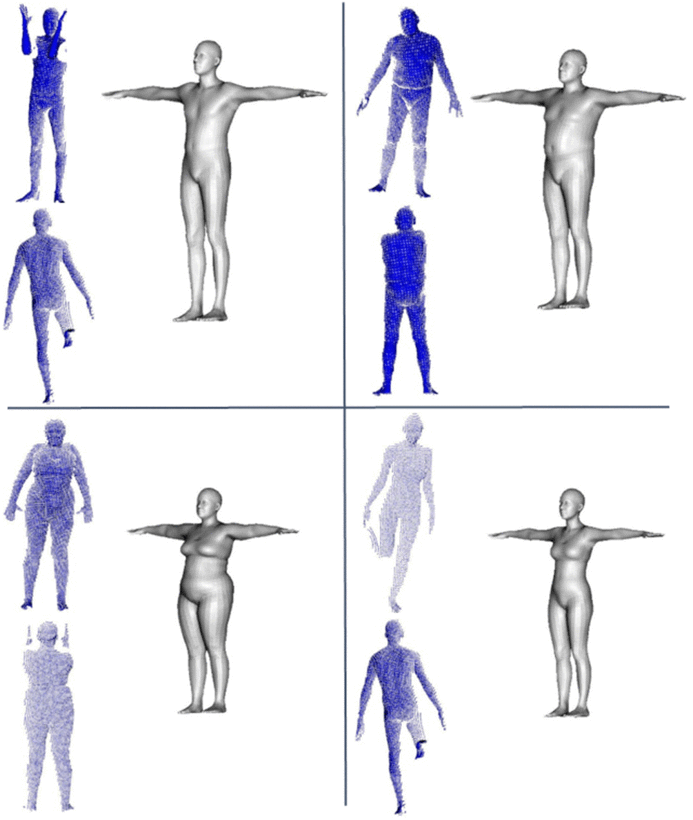Reconstructing 3D Shapes


Introduction
Knowledge about individual body shape has numerous applications in various domains such as healthcare, fashion and personalized entertainment. Most of the depth based whole body scanners need multiple cameras surrounding the user and requiring the user to keep a canonical pose strictly during capturing depth images. These scanning devices are expensive and need professional knowledge for operation. In order to make 3D scanning as easy-to-use and fast as possible, there is a great demand to simplify the process and to reduce the hardware requirements. In [Hu et al. IEEE TMM2022], we propose a deep learning algorithm, dubbed 3DBodyNet, to rapidly reconstruct the 3D shape of human bodies using a single commodity depth camera. As easy-to-use as taking a photo using a mobile phone, our algorithm only needs two depth images of the front-facing and back-facing bodies. The proposed algorithm has strong operability since it is insensitive to the pose and the pose variations between the two depth images. It can also reconstruct an accurate body shape for users under tight/loose clothing. Another advantage of our method is the ability to generate an animatable human body model. Extensive experimental results show that the proposed method enables robust and easy-to-use animatable human body reconstruction, and outperforms the state-of-the-art methods with respect to running time and accuracy.
In addition to human body shape reconstruction [Hu et al. IEEE TMM2022, Zhang et al. MIG2019], our team has expiernece in reconstrucitng different kinds of obejcts [Kulikajevas et al. Sensors2020]. 3D car models are heavily used in computer games, visual effects, and even automotive designs. As a result, producing such models with minimal labour costs is increasingly more important. To tackle the challenge, we propose a novel system to reconstruct a 3D car using a single sketch image [Nozawa et al. TVC2022, Nozawa et al. GRAPP2020, Nozawa et al. MIG2019]. The system learns from a synthetic database of 3D car models and their corresponding 2D contour sketches and segmentation masks, allowing effective training with minimal data collection cost. The core of the system is a machine learning pipeline that combines the use of a generative adversarial network (GAN) and lazy learning. GAN, being a deep learning method, is capable of modelling complicated data distributions, enabling the effective modelling of a large variety of cars. Its major weakness is that as a global method, modelling the fine details in the local region is challenging. Lazy learning works well to preserve local features by generating a local subspace with relevant data samples. We demonstrate that the combined use of GAN and lazy learning produces is able to produce high-quality results, in which different types of cars with complicated local features can be generated effectively with a single sketch. Our method outperforms existing ones using other machine learning structures such as the variational autoencoder.
In addition to human body shape reconstruction [Hu et al. IEEE TMM2022, Zhang et al. MIG2019], our team has expiernece in reconstrucitng different kinds of obejcts [Kulikajevas et al. Sensors2020]. 3D car models are heavily used in computer games, visual effects, and even automotive designs. As a result, producing such models with minimal labour costs is increasingly more important. To tackle the challenge, we propose a novel system to reconstruct a 3D car using a single sketch image [Nozawa et al. TVC2022, Nozawa et al. GRAPP2020, Nozawa et al. MIG2019]. The system learns from a synthetic database of 3D car models and their corresponding 2D contour sketches and segmentation masks, allowing effective training with minimal data collection cost. The core of the system is a machine learning pipeline that combines the use of a generative adversarial network (GAN) and lazy learning. GAN, being a deep learning method, is capable of modelling complicated data distributions, enabling the effective modelling of a large variety of cars. Its major weakness is that as a global method, modelling the fine details in the local region is challenging. Lazy learning works well to preserve local features by generating a local subspace with relevant data samples. We demonstrate that the combined use of GAN and lazy learning produces is able to produce high-quality results, in which different types of cars with complicated local features can be generated effectively with a single sketch. Our method outperforms existing ones using other machine learning structures such as the variational autoencoder.
Publications
The Team
Dr. Pengpeng Hu
Post Doc Researcher, Vrije Universiteit Brussel